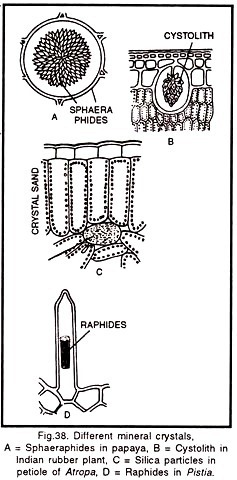ADVERTISEMENTS:
The following points highlight the nine main excretory materials formed in plants. The excretory materials are: 1. Alkaloids 2. Essential Oils 3. Latex 4. Glucosides 5. Tannins 6. Resins 7. Gums 8. Organic Acids 9. Mineral Crystals.
1. Alkaloids:
This term was given by W. Meissner (1819). These are nitrogenous excretory matters made up of C.H, O and N. These are insoluble in water, soluble in alcohol, sour in taste, many of them poisonous and some one used as medicines are found in storage organs of the plant such as seeds, leaves, bark etc.
The examples are:
ADVERTISEMENTS:
(a) Aconite – Obtained from Aconitum (Family—Ranunculaceae).
(b) Atropine – Obtained from Atropa belladona (Family—Solanaceae). It activates sympathetic nervous system, dilates the pupil of eyes.
(c) Quinine – Obtained from Cinchona officinalis—bark (family—Rubiaceae, medicine for malaria).
(d) Morphine – Obtained from latex of poppy fruit, Papaver somniferum (Family—Papaveraceae) used as pain reliever and helps in sound sleep.
ADVERTISEMENTS:
(e) Reserpine – Obtained from roots of Rauwolfia serpentina roots (Family—Apocyanaceae, medicine for reducing blood pressure).
(f) Strychnine – Obtained from seeds of nux vomica (Strychnos), Family—Loganiaceae, provides strength to body.
(g) Vasicine – Obtained from Vasica adhatoda (Family—Acanthaceae)
(h) Cocaine – Obtained from Erythroxylon coca (Family—Erythroxylaceae.)
(i) Santonin – Obtained from Artemesia cina (Family—Compositae)
(J) Thein – Obtained from tea leaves (a stimulant).
(k) Caffeine – Obtained from roasted seeds of coffee (pain reliever and nervous system activator.)
(l) Nicotine – Obtained from leaves of tobacco (acts as narcotic) Family—Solanaceae.
(m) Ephedrine – Obtained from Ephedra (gymnosperms).
ADVERTISEMENTS:
(n) Ergot alkaloids – Obtained from Claviceps purpurea (Fungus).
2. Essential Oils:
These are volatile oils which are mostly found in specialized cells or glands. The fragrance confined within some flowers, leaves, epicarp of fruits, bark, seeds is due to these essential oils. These are used in manufacturing of medicines, soap etc. In addition, they attract several insects towards them, thus, helpful in pollination.
These are some essential oils available from the following plants:
(i) Jasminum arborescens (Chameli)
ADVERTISEMENTS:
(ii) Citrus reticulata (Orange)
(iii) Citrus lemon (Lemon)
(iv) Rosa damascena (Rose)
3. Latex:
This is white, yellow or brownish coloured milky substance, colloidal in nature. In fact this is emulsion. It is used in wound healing. In the latex of papaya papain enzyme is found which helps in digestion of protein containing food. Rubber of commercial value is made from latex of rubber plant (Heavea braziliensis) which belongs to family Euphorbiaceae.
ADVERTISEMENTS:
Other plants which exudate latex are as follows:
4. Glucosides:
They are formed by degradation of carbohydrate and some of one are used as medicines. Digitoxin, a glucoside used for heart trouble is obtained from Digitalis purpurea.
5. Tannins:
These are related with glucosides and are of bitter and sour taste. These are found in cell sap, cell wall, leaves, barks etc. These are more present in un-ripened fruits and decrease as the fruit ripens. These are mostly used in manufacturing medicines, ink and hardening leather.
ADVERTISEMENTS:
Haematoxylin stain is prepared from Haematoxylon campechianum (Family—Caesalpiniaceae) used in staining the tissues. Kathha is obtained from the heart wood of Acacia catechu (Family—Mimosoideae) used as dye and eaten with betel leaves.
6. Resins:
These are formed by the oxidation of essential oils. These are insoluble in water and soluble in alcohol and ether, present in special types of glands or in canals either in group or alone with gums and essential oils. These are used in manufacturing paints and varnish. Heeng (Asafoetida), Ferula assafoetida (Family—Umbelliferae) is a resin which is produced from its succulent roots in milky form and used in manufacturing of medicines.
7. Gums:
This is formed due to disintegration of cellulose made cell wall & soluble in water. This excretes in the form of mucilaginous substance which acts as sticking substance. It is also used in manufacturing of medicines.
8. Organic Acids:
These are commonly found in leaves and fruits of plants. Citric acid is found in Citrus (Family—Rutaceae), Oxalic acid in Oxalis, Tartaric acid in fruits of Imli (Tamarindus indica, Family—Caesalpiniaceae), malic acid in cacti, Opuntia (Family—Cactaceae) and specially in CAM plants where stomata remain open in night and closed in day time (Scotoactive stomata).
9. Mineral Crystals:
Crystals of various minerals are found in plants as waste products. These crystals are made up of calcium oxalate or calcium carbonate. The crystals of calcium carbonate are found in cellulose walls. In banyan (Ficus) leaves are developed in the shape of bunch of grapes and are said as Cystolith.
The presence of cystolith is also found in plants belonging to family Cucurbitaceae and Acanthaceae. Crystals of calcium oxalate are mostly found in storage organs of the plant like cortex and pith.
ADVERTISEMENTS:
In general, the mineral crystals found in the plants are rod- like, prismatic, pyramidal, needle shaped or rhomboidal. The needle shaped crystals are called Raphides e.g., Pistia, Eichhornia, onion etc.
These crystals are usually present in mucilage containing cells and are called Idioblasts. Some mineral crystals in group form a spherical structure as in Carica papaya (papaya) are termed as druses or Sphaerocrystals (= Sphaeraphides).

